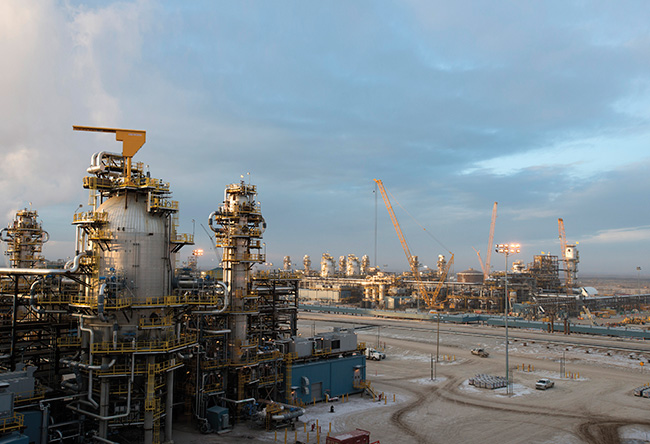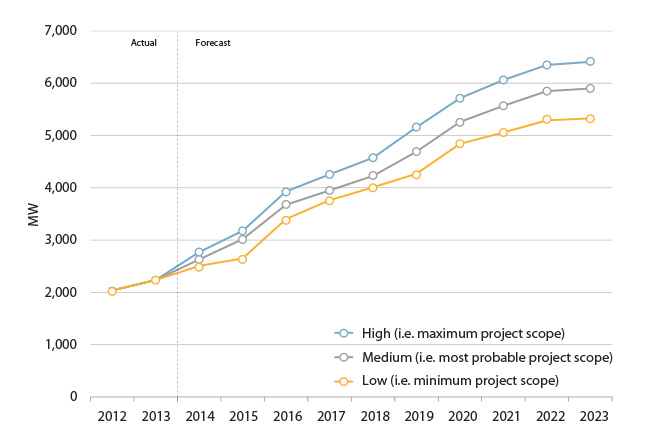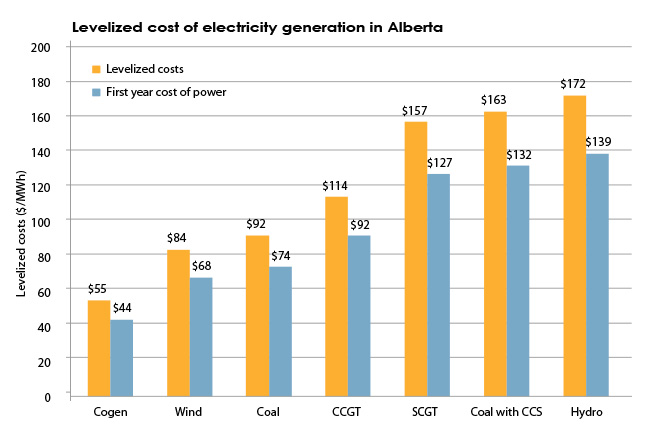Co-Benefits: Timing right for higher-efficiency, lower-emission cogeneration to power the oilsands
- Published: Tuesday, 01 September 2015
- Author: Jim Bentein
EDC Associates, a Calgary-based economics consulting firm, looked at the prospects for more cogeneration plants being developed in Alberta, particularly in the oilsands. The title of the study, produced in May, 2014, says it all: Full Steam Ahead.
The firm, which specializes in the analysis of energy pricing and procurement and the electricity sector, concluded that the potential for cogeneration in Alberta is far beyond the approximately 4,500 megawatts (MW) that exist now, even though that already represents a substantial amount of the more than 16,000 MW of installed capacity in Alberta.
 (PHOTO: IMPERIAL OIL)
(PHOTO: IMPERIAL OIL)
Duane Reid-Carlson, president of the company, says the province’s industry-intensive power consumption, along with the size of its oilsands sector—which has what the report called “a voracious appetite” for steam, which cogeneration facilities produce along with electricity—means the technology is a perfect match for the province’s electricity sector.
In addition, he says the recent move by the newly elected NDP government to phase in an increase in the carbon fee on heavy industry in the form of the Specified Gas Emitters Regulation, which will raise the fee to as much as $6 per tonne by 2017 from a maximum $1.80 now, provides an added incentive for the development of cogeneration. Cogen is less CO2-intensive than a combined cycle natural gas plant or a modern coal-fired plant.
“The [former] Conservative government was looking at carbon capture and storage to play a role in reducing greenhouse gas [GHG] emissions, but the NDP is talking about more of a reliance on cogeneration,” says Reid-Carlson, emphasizing that’s his personal view. “Cogen produces half to two-thirds of the GHG emissions of a combined cycle gas plant and one-quarter to one-half of those from a coal-fired plant [equipped with CO2reduction technology].”
Cogen is valued in Alberta’s highly industrialized economy, where, according to Evan Bahry, executive director of the Independent Power Producers Society of Alberta (IPPSA), 65 per cent of electricity demand comes from the industrial sector, the highest percentage in North America.
“With cogen the steam is the driver, plus it gives you on-site, reliable power,” he says.
Anticipated installed cogeneration capacity
 (SOURCE DESIDERATA ENERGY CONSULTING)
(SOURCE DESIDERATA ENERGY CONSULTING)
In their report EDC says one of the largest forces leading to the need for more cogen is the shift to SAGD technology in the oilsands, which the firm calls “the perfect environment” for the technology.
“With cogen, natural gas is burned directly at the blades of a gas combustion turbine, which spins a generator to make electricity,” the consultants explained. “The extremely hot exhaust gasses are passed through a heat recovery steam generator (HRSG), which extracts the waste heat to boil steam. The steam is then put to work in its host’s process, replacing steam otherwise produced by a traditional stand-alone steam boiler.”
They went on to explain that the simultaneous creation of electrical energy and steam energy is much more efficient than creating the two separately, achieving up to 90 per cent efficiency.
EDC, which also offers a course in cogen economics, believes the technology is massively underutilized in the province.
However, it is a growing source of generation capacity as part of Alberta’s total generation of about 16,224 MW (it also imports 1,250 MW). Coal-fired electricity is still the largest source of generation, supplying 6,271 MW of electricity, or about 39 per cent of in-province generation. Cogen is next, with 4,431 MW of generation, or 27 per cent of the in-province total. Combined cycle is next, providing 11 per cent, while simple cycle gas provides seven per cent. Wind provides about nine per cent of the total, with hydro and biomass providing the rest.
 (SOURCE: SOLAS ENERGY CONSULTING)
(SOURCE: SOLAS ENERGY CONSULTING)
EDC forecasts that the cogen fleet will grow to almost 5,500 MW in the next seven years, with about 2,300 MW being sent to the grid.
While most of the other generation sources contribute as much to the power grid as they produce, cogen only delivers about 1,850 MW, about one-third of its total output. The reason for that, of course, is that much of the electricity cogen units produce is consumed “in-house” by those entities producing it.
While the SAGD sector has been a popular and logical area for the adoption of the technology, it’s not the only area where cogen has been deployed. For instance, the University of Alberta, the University of Calgary and SAIT Polytechnic all have smaller cogen units. In addition, there is a 474 MW cogen plant at the Nova Chemicals petrochemical plant at Joffre and another 326 MW cogen unit at the Dow Chemical plant near Edmonton. There are also cogeneration units at forestry plants near Grande Prairie and Lac La Biche and at heavy oil upgraders.
Oilsands producers Suncor Energy and Syncrude Canada are large cogen users, with Suncor having a total of 901 MW of generation (with smaller units scattered at various mining and SAGD sites), and Syncrude deploying 510 MW of cogen, also scattered at various sites.
Reid-Carlson argues that that the potential for cogen utilization is much greater than has been realized, particularly in the SAGD sector, but with potential in urban centres as well, particularly at manufacturing facilities.
“It’s a logical technology because there are so many advantages, including environmental, offering great efficiency and reliability,” he says.
So why isn’t more cogen being developed?
There are several reasons, he says, one of them being that the logical builders, those SAGD plant operators, are facing capital constraints now. At current low oil prices, investing in a cogeneration plant is unlikely, especially for mid-size companies involved in the oilsands.
Although costs can vary, the U.S.-based Centre for Climate and Energy Solutions, which is a proponent of the technology, estimates the cost of a 50 MW gas turbine cogen facility would be about US$45 million. It estimates cogen, which is deployed at about 3,300 sites in the U.S., provides about 12 per cent of the country’s electricity.
The other factor is that SAGD plant operators are focused on bitumen production and building a cogen plant means “they’re entering a world they’re not familiar with,” he says.
Larger operators, such as Suncor, Syncrude and Imperial Oil, can afford to retain employees who are familiar with and dedicated to operating cogen plants, he says. In fact, when Syncrude and Suncor first got involved in cogen they partnered with major utilities, but now they operate the plants themselves.
One of the impediments in recent years was the spike in natural gas prices, which challenged the economics of cogen, he says. That tended to discourage new investment in the plants in the early part of this decade. However, with gas prices low and likely to stay there, that is another incentive to use the technology, says Reid-Carlson. “These are 40- or 50-year assets,” he says, which means even if gas prices rise the technology still makes sense.
Because of the efficiency of cogen, he says they have a 25 per cent cost advantage over combined-cycle gas plants, “but combined-cycle is what the utilities are building.” An example of that is Enmax Energy’s new Shepard Energy Centre in Calgary, the province’s largest natural gas–fuelled power facility, generating 800 MW of power.
There are now some third party proponents of cogen hoping to work with SAGD operators and others to build and operate cogen plants, he says.
In addition to the environmental, efficiency and other arguments in favour of cogen, he says “behind-the-fence” consumption offers users yet another advantage of utilizing cogen: greater reliability, with no need to tap the power grid. Given new provincial legislation mandating the development of costly new transmission lines, he says the future cost of tapping the grid for power is sure to rise.
Although his firm has not conducted a thorough economic analysis, Reid-Carlson believes a shift to cogen from combined-cycle power units, which are considered very efficient, could lead to a 25 per cent cost savings.
In any case, the province’s coal-reliant power fleet will see a significant shift in the next few decades to cleaner, gas-fired power, says Bahry. “We expect an orderly replacement of our province’s coal fleet by natural gas supply, as it represents the most cost- effective baseload supply that can be built in a timely manner,” he says.
By 2050, IPPSA sees just 929 MW of coal power remaining, even though it forecasts power generation will double to 30,000 MW by then.
IPPSA, which champions Alberta’s deregulated power system, the only one in Canada, argues that it has produced a competitive marketplace that has made power rates some of the lowest in North America.
It will also be a system that will have a much lower environmental footprint, thanks to the shift to gas. “By 2030 our emissions intensity is forecast to fall in half,” Bahry says.
That will occur while gas-fired power provides about 80 per cent of the province’s generation, with wind providing about 15 per cent. In 2013 EDC produced a study for IPPSA, Trends in GHG Emissions in the Alberta Electricity Market, which forecast that outcome. However, new policy directions suggested by Alberta’s new government, such as a speed-up of coal power plant retirements and an increased emphasis on renewable power, could change those estimates.
Reid-Carlson thinks it’s quite possible higher carbon levies will lead to a retirement of the entire coal-fired fleet prior to 2050, leaving room for more cogen and other gas-fired alternatives, and possibly more wind.
Imperial Oil is one of the province’s largest users of cogen at its Cold Lake Project, an in situ oilsands operation, where vast amounts of steam are used, as well as at its Kearl oilsands mining project, north of Fort McMurray.
“We like cogen because it gives you a higher degree of reliability because your power is provided on site, rather than relying on the transmission grid,” says Imperial spokesperson Pius Rolheiser.
It first used cogen at its 40,000-bbl/d Mahkeses plant, which went into operation in 2004 at Cold Lake. It built a 170 MW unit there. It was so happy with the results of that move, it included a similar-sized cogen unit in the 40,000-bbl/d Nabiye phased expansion, which went into operation late last year.
It won’t reveal what it spent on the cogen units themselves, but the entire cost of the Nabiye plant was $2 billion. It spent $650 million on Mahkeses. It now produces about 160,000 bbls/d of bitumen at Cold Lake.
At Kearl, where it has spent about $21.8 billion on two phases, which eventually will produce 345,000 bbls/d, it built an 85 MW cogen plant.
The Cold Lake plant, which was described by the late Howard Dingle, an Imperial Oil executive who managed the project in the 1980s, as “a massive water recycling operation that also produces bitumen,” involves the injection of 500,000 barrels of water per day, in the form of steam, to produce bitumen. Ninety per cent of the water is recycled.
Rolheiser says using cogen has led to a 40 per cent reduction in GHGs compared to using electricity from the grid and having conventional boilers.
It uses about 190 MW of the total cogen power it produces at Cold Lake now and sells about 150 MW to the grid. However, Imperial has long-term plans to expand the plant, which would require more of that power to be used on site. At Kearl, where large volumes of steam are also used, similar GHG reductions are expected, he says. The company has applied to the Alberta Utilities Commission to “build future cogen capacity at Kearl, based on our needs,” he says.
-NTM-





